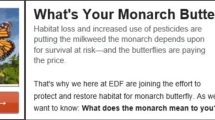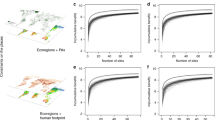Abstract
Some conservation organizations publish magazines that showcase current conservation and research projects, attract new subscribers and maintain membership, often using flagship species to promote these objectives. This study investigates the nature of flagship species featured on the covers of ten representative US conservation and nature magazines, Defenders, National Wildlife, Wildlife Conservation, Zoonooz, Nature Conservancy, Outdoor America, Sierra, Audubon, California Wild and Natural History. Operationally defining flagship species by diet, taxonomic order, body size and IUCN status, we found that magazines tend to use mammal and bird species rather than invertebrate, fish, amphibian, reptile or plant taxa on their covers. Featured birds were mostly omnivorous or piscivorous, large-bodied and of little conservation concern; featured mammals were mainly carnivorous or herbivorous, large-bodied and of considerable conservation concern. These analyses confirm, for the first time, anecdotal observations about conservation organizations focusing their publicity and programmes on large, charismatic species to raise awareness and funds and raise the spectre that the public may be exposed to only a selected sample of conservation problems.





Similar content being viewed by others
References
Andelman SJ, Fagan WF (2000) Umbrellas and flagships: efficient conservation surrogates or expensive mistakes? Proc Natl Acad Sci 97:5954–5959
Blackburn TM, Gaston KJ (1994) The distribution of body sizes of the world’s bird species. Oikos 70:127–130
Bowen-Jones E, Entwistle A (2002) Identifying appropriate flagship species: the importance of culture and local contexts. Oryx 36:189–195
Bradley DR, Bradley TD, McGrath SG, Cutcomb SD (1979) Type I error rate of the Chi-square test of independence in R X C tables that have small expected frequencies. Psychol Bull 86:1290–1297
Burghardt GM, Herzog HA (1980) Beyond conspecifics: is brer rabbit our brother. BioScience 30:763–768
Caro TM, O’Doherty G (1999) On the use of surrogate species in conservation biology. Conserv Biol 13:805–814
Caro T, Engilis A Jr, Fitzherbert E, Gardner T (2004) Preliminary assessment of the flagship species concept at a small scale. Anim Conserv 7:63–70
Czech B, Krausman PR, Borkhataria R (1998) Social construction, political power, and the allocation of benefits to endangered species. Conserv Biol 12:1103–1112
Downer CC (1996) The mountain tapir, endangered ‘flagship’ species of the high Andes. Oryx 30:45–58
Dunning JB (ed) (1993) CRC handbook of avian body masses. CRC Press, Boca Raton, FL
Estes JA, Tinker MT, Williams TM, Doak DF (1998) Killer whale predation on sea otters linking oceanic and nearshore ecosystems. Science 282:473–476
Gardezi T, da Silva J (1999) Diversity in relation to body size in mammals: a comparative study. Amer Nat 153:110–123
Heywood VH (ed) (1995) Global biodiversity assessment. Cambridge University Press, Cambridge, UK
Johnsingh AJT, Joshua J (1994) Conserving Rajaji and Corbett National Parks—the elephant as a flagship species. Oryx 28:135–140
Kaltenborn BP, Bjerke T, Nyahongo W, Williams DR (2006) Animal preferences and acceptability of wildlife management actions around Serengeti National Park, Tanzania. Biodivers Conserv 15:4633–4649
Kellert SR (1985) Social and perceptual factors in endangered species management. J Wildlife Manage 49:528–536
Kellert SR, Black M, Reid Rush C, Bath AJ (1996) Human culture and large carnivore conservation in North America. Conserv Biol 10:977–990
Leader-Williams N, Dublin HT (2000) Charismatic megafauna as ‘flagship’ species. In: Entwistle A, Dunstone N (eds) Has the Panda had its day? Future priorities for the conservation of mammal diversity. Cambridge University Press, Cambridge, UK, pp 53–81
MacDonald D (ed) (2001) The new encyclopedia of mammals. Oxford University Press, Oxford, UK
Munoz J (2007) Biodiversity conservation including uncharismatic species. Biodivers Conserv 16:2233–2235
Ord TJ, Blumstein DT (2002) Size constraints and the evolution of display complexity: why do large lizards have simple displays? Biol J Linn Soc 76:145–161
Perrins C (ed) (2003) The new encyclopedia of birds. Oxford University Press, Oxford, UK
Sergio F, Newton I, Marchesi L (2005) Top predators and biodiversity. Nature 436:192
Silva M, Downing JA (1995) CRC handbook of mammalian body masses. CRC Press, Boca Raton, FL
Walpole MJ, Leader-Williams N (2002) Tourism and flagship species in conservation. Biodivers Conserv 11:543–547
Wilson DE, Reeder DM (eds) (2005) Mammal species of the world. Johns Hopkins University Press, Maryland
Acknowledgments
B.C. and K.M. were both supported by National Science Foundation fellowships. We thank the Animal Behavior Graduate Group Thursday night meetings, Annie Leonard, and Andy Marshall for useful suggestions.
Author information
Authors and Affiliations
Corresponding author
Rights and permissions
About this article
Cite this article
Clucas, B., McHugh, K. & Caro, T. Flagship species on covers of US conservation and nature magazines. Biodivers Conserv 17, 1517–1528 (2008). https://doi.org/10.1007/s10531-008-9361-0
Received:
Accepted:
Published:
Issue Date:
DOI: https://doi.org/10.1007/s10531-008-9361-0




